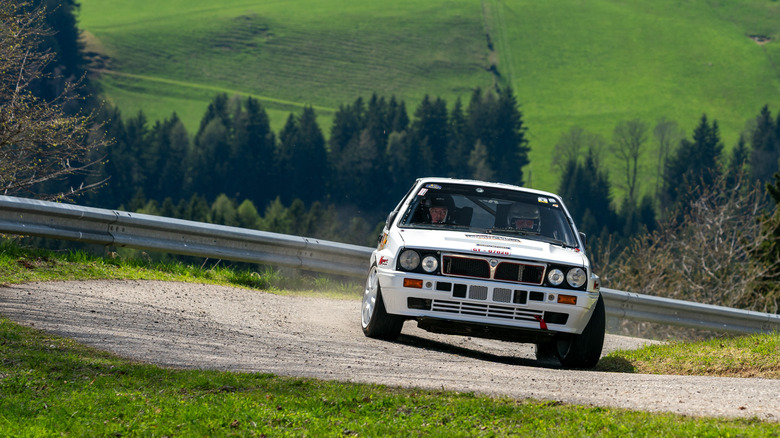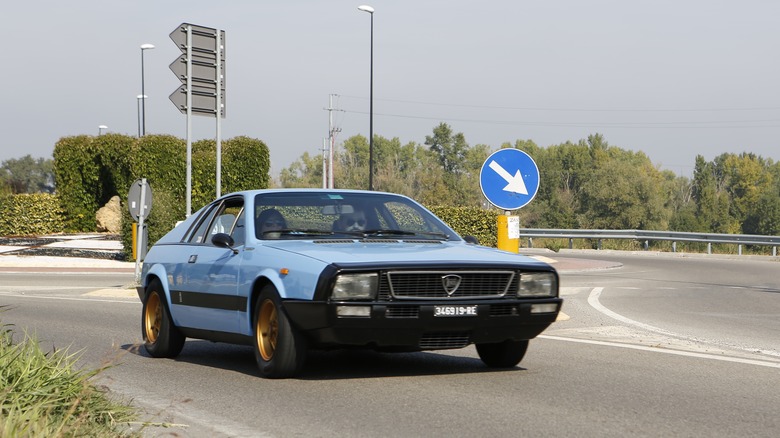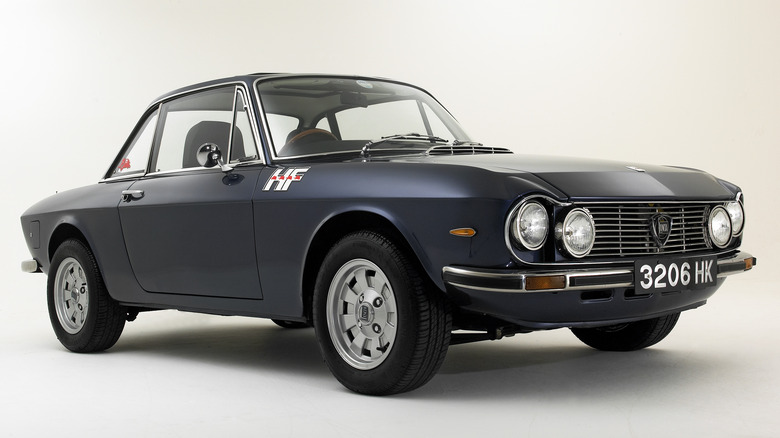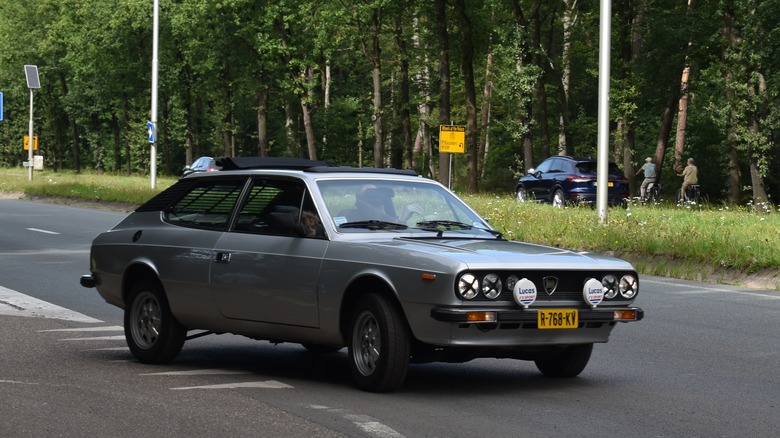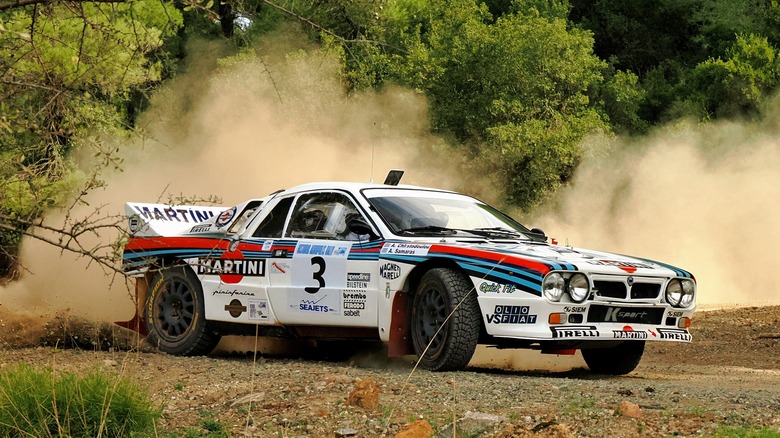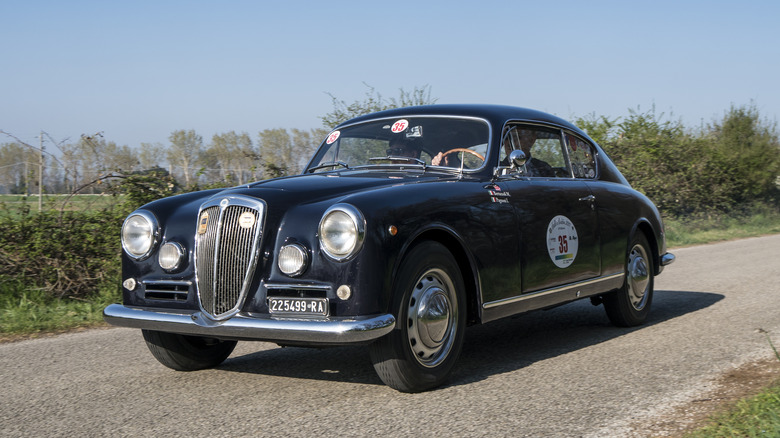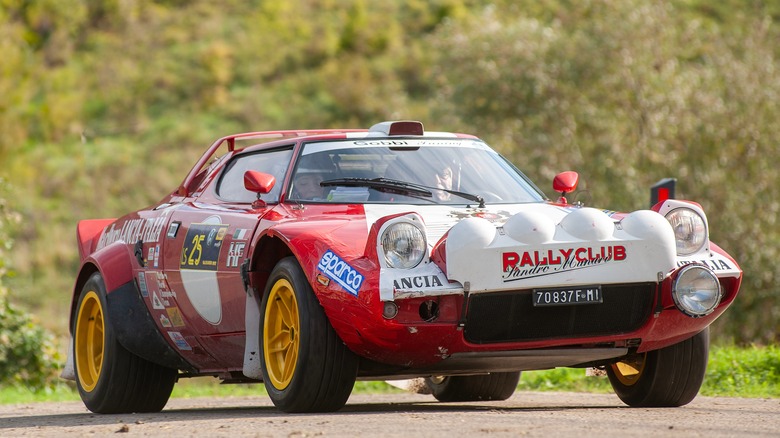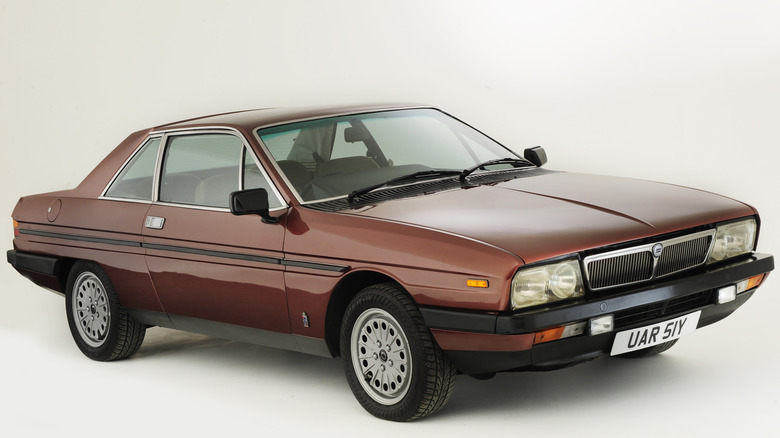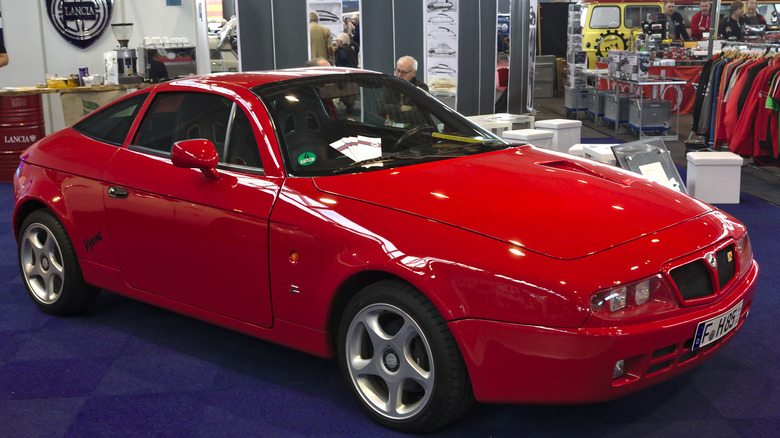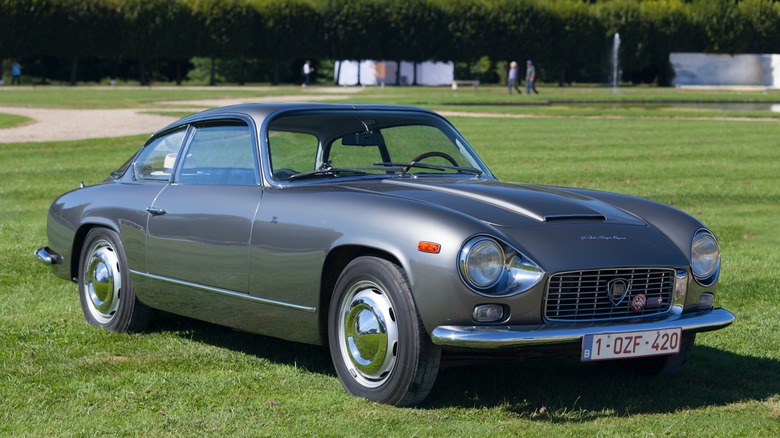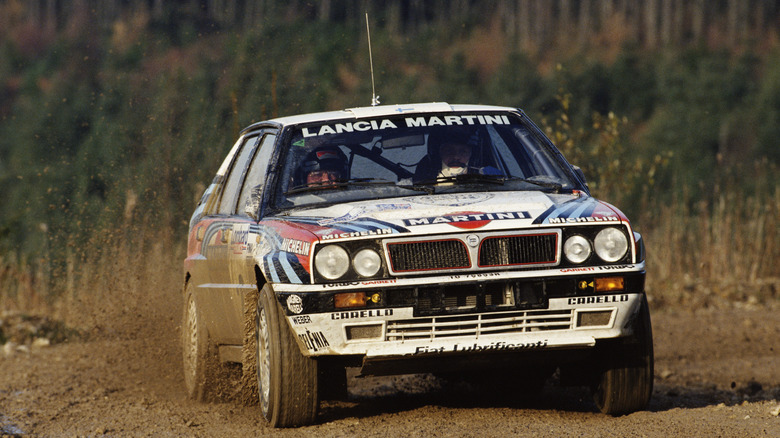10 Of The Coolest Lancia Models That Will Always Turn Heads
In the realm of Italian cars, everyone always talks about Lamborghini, Ferrari, Pagani, Alfa Romeo, and so on, leaving other amazing automakers in the shadows. Italian cars don't exactly have a stellar reputation for reliability, and this has led to people avoiding them and constantly making jokes about them any chance they get. That's certainly the case with Lancia.
Founded in 1906 in Turin, Italy Lancia's cars haven't always been the greatest. However the company has had some truly pioneering ideas, and it remains one of the most successful manufacturers in all of motorsport history, especially on the world rally circuit. While everyone respects Lancia for its success and some of its greatest cars, they also can't help but make rust and bad engineering jokes every once in a while.
While some of those jokes may be warranted, there's one other thing that Lancia has almost always completely nailed: the designs of its cars. No matter what type of vehicle it was, a Lancia was a much more flamboyant choice than, say, a Volkswagen or an Audi back in the '70s and '80s, and even before that. While the brand is a shadow of its former self today, preferring to focus its efforts on electric cars, some of its most iconic cars remain head-turners to this day.
Lancia Montecarlo / Scorpion
Incidentally one of the only Lancia vehicles to be offered in North America, the Scorpion (also known as the Beta Montecarlo and just simply the Montecarlo) is yet another member of the group of cars people consistently refer to as mini Ferraris. And in the case of the Montecarlo, it very much deserves that title.
Unlike fellow mini Ferraris like the Fiat Coupe, the Lancia Montecarlo had its engine in the middle and it was RWD. Of course, it wasn't a V8, but rather a more humble four-cylinder unit. It displaced 2.0 liters in the majority of global markets, but it received a heavily nerfed 1.8-liter four-cylinder in North America. The styling of the Montecarlo really was something to behold, and we have Pininfarina to thank for that.
Pininfarina was actually fully in charge of the Montecarlo's assembly and production at its Turin facility, and it was one of the first ever cars to be designed and built using CAD. Despite using parts from various other Fiat and Lancia vehicles, the Montecarlo was special, and remains one of the most underrated small sports cars of its day, though it is not without its faults. If you sneezed on it, it would start to rust, and the earliest models also suffered from an infamous where their really strong brake servos would lock up the wheels involuntarily. Lancia's eventual solution? Removing the brake servo completely. Genius!
Lancia Fulvia
At its core, the Lancia Fulvia was just an ordinary family car, but it was the coupe version that set the world on fire. This was one of the first production cars to use a V4, rather than an I4 engine, way before Volkswagen made narrow angle V engines cool. The Group 4 Fulvia HF made 165 hp, which was plenty considering it weighed just 1,818 pounds. It was also among the first production cars to have four-wheel disc brakes.
A direct result of that excellent engineering: The Lancia Fulvia was the first car from the automaker to take home the World Rally Championship title in 1972. This started a chain reaction of Lancia being almost completely unstoppable in the World Rally Championship into the 1990s.
As well as being innovative and highly skilled on the rally circuit, the Fulvia was a looker. Penned by Piero Castagnero, the design was simple, but very elegant and svelte. Believe it or not, the Fulvia actually had a pretty reliable engine too, but rust was still a major issue. Despite its flaws, it's a fantastic piece of both rally and Italian car history, and a reminder of what Lancia could do on the rally stages of the world.
Lancia Beta HPE
The Beta was one of the staples of Lancia's lineup in the '70s and '80s. The family sedan was designed to compete with the Alfa Romeo Alfetta, the BMW 5 Series, and so on. After the acquisition of Lancia by Fiat in the late '70s, a new addition to the Beta family took on the form of one of automotive design's most unfortunate casualties: the shooting brake.
Named the Beta HPE and introduced in 1975, it was a classic interpretation of the shooting brake: A two-door long roof with a massive cargo area. Once again, Pininfarina was in charge of the styling, and successfully managed to make even the HPE look fantastic. While maybe not as classically beautiful as other Lancias, it was still definitely memorable.
Being a Lancia, there was plenty of innovation, including MacPherson strut suspension on all four corners — pretty unusual by mid-'70s standards. Metal oxidation is, as expected, another thing to look out for in the Beta HPE, but the rest is fairly sturdy if it's been well-maintained.
Lancia Rally 037
The 1980s were quite the time in the world of motorsport, due in large part to the inception of Group B. In the WRC, Group B was essentially the free-for-all group, where there were virtually no restrictions and only the most basic of rules like homologation. Lancia entered the Group B scene in the early '80s with what would go on to become one of the icons of the sport, the Rally 037.
Known simply as the 037, the mid-engined beauty was powered by an Abarth-engineered (yes, that Abarth) supercharged 2.0-liter four banger, which drove only the rear wheels. This seemed problematic at first, as Group B was dominated by AWD competitors, most notably the iconic Audi Quattro. Indeed, the Quattro was the car that Lancia set out to dethrone.
Despite the 037's disadvantage, through a little bit of cunning, Lancia went on to win the championship in 1983 with the Martini Racing-decorated 037, marking the last time in the sport's history that a 2WD car took home the title. The story of the win is absolutely incredible, and it's beautifully told in both the Grand Tour and the 2024 Audi vs Lancia feature film. Nowadays, the 037's legacy is honored by a lustful restomod from Kimera.
Lancia Aurelia B20
Let's wind the clock back a little before the heyday of Lancia in the '70s and '80s. Despite not being quite as fondly remembered as the Delta, 037, and Stratos, the Lancia Aurelia was a success in motorsport long before them, taking home victories in rally championships and Le Mans throughout the 1950s.
Launched in the early '50s, the Aurelia B20 was one of the forerunners of the 2+2 grand tourer automotive format, and it was the first production car in the world to use a V6 engine. Production was handled by Pininfarina once again, but the bodywork was designed by (comparative) underdog design house Ghia. While it was unmistakably a Lancia, the Aurelia B20 took on a very different form compared to the regular Aurelia.
The standard Aurelia was a typical '50s sedan, but the B20 was a svelte coupe with a particularly notable low roofline, easily making it one of the most classically beautiful cars not just of its day, but today as well. Even the classic elegance of cars like the BMW 507 seemed lacking in comparison. Despite the V6 not being very powerful or especially big, the Aurelia B20 would take podium in the 1951 Mille Miglia. Not bad for 75 hp.
Lancia Stratos
After the more conventional Fulvia took home the world rally championship in 1972, Lancia got to work on a radically new rally car that would go on to become one of the most respected and iconic cars in the WRC. Launched in the mid-'70s, the Stratos was designed from day one to do one thing and one thing only: show the competition who's boss on the rally stage.
Bertone's, specifically designer Marcello Gandini's, Stratos Zero formed the basis of both the race car and the road car. The car featured two massive opening panels, which made it easy to gain access to the internal components. Its tiny footprint and extremely short wheelbase made it very agile, but also a little dangerous.
Power came from a 2.5-liter naturally aspirated V6 sourced from the Ferrari Dino 246, which made anywhere from 280 to 320 hp. That's a good amount by modern standards, and an immense amount for the '70s, especially in a car weighing 2,160 pounds. Being a Lancia, it was saddled with a few issues. As Jeremy Clarkson pointed out in an old episode of "Top Gear," it's very difficult to get comfortable behind the wheel of the Stratos. Still, adorned with the iconic Alitalia livery, the Stratos won three consecutive world rally championships, as well as the Targa Florio.
Lancia Gamma
Back to the more conventional part of Lancia. The Gamma was the automaker's flagship sedan coupe due from the mid-'70s to the mid-'80s, replacing the gorgeous Flavia. The Gamma, too, was a lovely looking thing regardless of the body style, but the coupe really holds a special place in the hearts of many.
The low hoodline was made possible by the use of a boxer engine, which was a rarity in Europe at the time. Porsche had a history with boxer engines, but other European automakers never really gave it a shot. The low hood complimented the svelte rear end perfectly. For the most part, the Gamma was a solid premium family car. Though it did suffer from similar rust issues, that wasn't the Gamma's ultimate downside, however. That honor would have to go to the bizarrely engineered power steering pump.
In any other normal car, the crankshaft pulley is what usually makes the AC compressor, power steering pump, and so on tick. In the Gamma, the camshaft pulley handled the power steering pump, meaning that if you were to start up your Gamma with the steering wheel at full lock, you would have to say your goodbyes to the camshaft belt and the engine.
Lancia Hyena
The brainchild of Italian design house Zagato and a Dutch Lancia dealer, the Hyena is essentially what happens when you combine the Delta HF Integrale's incredible rally-ready underpinnings with a two-door coupe body that was quite ahead of its time. The Hyena came along in the early '90s, but the body bears a slight resemblance to stuff like the original Ford Puma, which came around in the late '90s and early 2000s.
In terms of rarity and exclusivity, the Hyena is right up there with the likes of the 037 and the Stratos, as roughly 20 of them are believed to still be around. There was supposed to be a larger production run, but between Lancia refusing to sell a bare chassis to the builders and the high production costs, it never happened.
Underneath the more modern, sporty bodywork, the Hyena is just a Delta HF Integrale, thus making it one of the most capable cars of its day. The Delta HF Integrale was an amazing hot hatchback for its day, squeezing over 200 hp from its turbo four-cylinder, which was sent to all four wheels. A Hyena is a very unlikely sight on the road, but if you see it, you're gonna remember it.
[Featured image by Alexander Migl via Wikimedia Commons |Cropped and scaled | CC BY-SA 4.0]
Lancia Flaminia
After the Aurelia ran its course, a replacement followed closely behind. That came in the form of the Flaminia, previewed by the Lancia Florida concept car in 1955. The Flaminia took on a couple of different forms, including a sedan and a coupe, the latter bearing more than a slight resemblance to the venerable Maserati 3500GT.
As the Aurelia was the first production car in the world to use a V6 engine, the Flaminia naturally continued the legacy, with a 2.5-liter unit in the initial run, later updated to a 2.8-liter with around 130 hp — plenty for the time period. The coach doors were a signature Lancia styling trait back in the day, though some felt they didn't quite seal properly on some of the earlier Lancia models.
There was also the Flaminia Presidenziale, a four-door convertible designed to transport the kind of person it was named after. There was also a collaboration with Zagato in the form of the stunning Flaminia Sport Zagato (pictured). Today, the Flaminia remains a somewhat forgotten part of Lancia history, but one definitely worth remembering all over again.
Lancia Delta HF Integrale
This is the car that a lot of people think of when they hear the name Lancia. For the most part, the Lancia Delta hatchback was Lancia's answer to the VW Golf, but the HF Integrale is a different animal. It had a crazy widebody, giant rear spoiler, AWD, flared fenders — the whole nine yards.
The HF Integrale Evoluzione and Evoluzione II were designed to homologate the Delta for use in the Group A class in the WRC. Like all Lancia rally cars in the '80s and '90s, it wore the Martini Racing livery proudly, and Lancia definitely had reason to be proud of it. The HF Integrale remains, to this day, one of the most successful rally cars of all time.
From the mid '80s to the early '90s, the Delta Integrale helped Lancia secure a total of 74 victories, 46 championship titles, and six consecutive constructor's championships, and the latter of those figures remains unmatched to this day. It's sad to see that current day Lancia is nothing compared to what it used to be. But cars like the Delta HF Integrale and all the above-mentioned will serve as a reminder of how truly great and innovative Lancia was, despite all their flaws and foibles.
